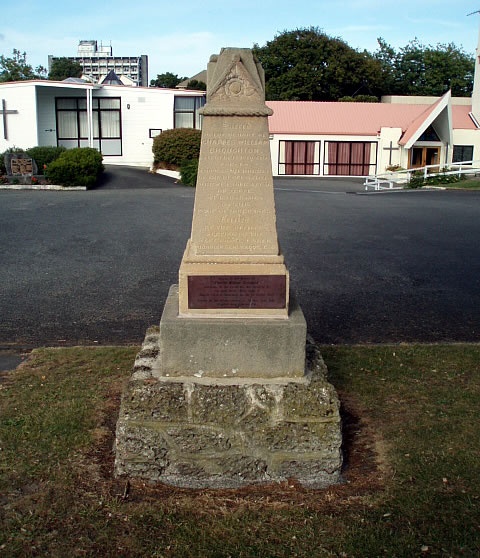
This memorial stands in the grounds of Christ Church on Wicksteed Street in Whanganui, a large town on the west coast of the North Island. It commemorates the government interpreter Charles William Broughton, who was killed at Kākaramea pa, north-west of Pātea, on 1 October 1865.
According to the contemporary historian T.W. Gudgeon, Broughton arrived in New Zealand in January 1852. Before war broke out he traded with Māori and was, for part of each year, based at ‘Marahowai’ (possibly Maraekōwhai), a settlement on the upper Whanganui River.
Broughton later became an interpreter for the Wellington provincial government, assisting Dr Isaac Featherston with the purchase of the Waitōtara block north-west of Whanganui.
The colonial government employed Broughton in a variety of roles during the New Zealand Wars. In 1864 he was interpreter to the commanding officer at Whanganui. On 26 June – alone and unarmed – he reclaimed the head of Captain Thomas Lloyd from the Pai Mārire (Hauhau) leader Te Ua Haumēne at a pā in the Waitōtara block. An officer in the 57th Regiment, Lloyd had been killed in an ambush at Te Ahuahu in Taranaki on 6 April. His preserved head subsequently circulated among Pai Mārire adherents as a spiritual trophy.
In early 1865, Broughton accompanied Lieutenant-General Duncan Cameron on his West Coast campaign. He was present at the engagements at Nukumaru (24–25 January) and Te Ngaio (13 March).
As Cameron’s campaign petered out, Broughton continued on to Weraroa pā, above the Waitōtara River. There he attempted to establish communications with Hauhau and circulate Governor George Grey’s terms of peace. Broughton was assisted by Kereti Te Ahuru, a Native Policeman who was attached to Brigadier-General Waddy’s staff as an orderly.
Broughton’s mission proved unsuccessful. On 22 September, the opposition of some Hauhau to peace was clearly demonstrated when Kereti was mortally wounded in an ambush within sight of the Weraroa redoubt. He died two days later.
On 26 September, a letter signed by several Hauhau was found on a pole near Pātea camp. This requested a meeting to discuss Grey’s peace proclamation. On Waddy’s orders, Broughton travelled to Pātea with Wiremu Pukapuka, an assessor (judicial official) from the Rangitīkei district.
Broughton and Pukapuka left the Pātea redoubt on 30 September with a small escort of troops. In front of Kākaramea pā, 6 km north-west of Pātea, Broughton met with several Māori under a white flag of truce. Refusing their invitation to enter the pā, he instead proposed that the meeting be held midway between their respective strongholds. When this proposal was rejected, the British party returned to Pātea.
The next day, 1 October, Broughton returned to Kākaramea with Pukapuka and an officer. Outside the pā, again under the truce flag, he was met by three Hauhau. One was Ruka, later described as Broughton’s former servant. This time Broughton accepted an invitation to enter the pā, despite protests from Pukapuka.
In a letter to the Minister for Colonial Defence, Lieutenant-Colonel Edward Gorton, commanding the Wanganui Militia District, stated:
Mr. Broughton went, and Wiremu Pukapuka and the officer returned to the [Patea] redoubt. Some time afterwards …, three shots were distinctly heard, and the red flag was hoisted instead of the white, and although thirty-six hours had elapsed when the news came in from Patea, no tidings had been heard of Mr. Broughton.
Gudgeon reported an eyewitness account of events inside Kākaramea pā:
When Ruka and Broughton entered the pa, they found the tribe assembled; but instead of the loud welcome of ‘Haere mai! Haere mai!’ … they were received in dead silence. As they entered the gate, Broughton saluted the Hauhaus, but received no reply, and saw, when too late, that his fate was sealed. He sat down for a few moments amidst the dead silence, and then, probably to hide his feelings, took out his pipe, walked towards the fire and began to light it. While thus engaged a native shot him through the back, and he fell partly upon the embers, where he writhed in agony until they dragged him off the fire and threw him over the cliff into the Patea River.
Broughton’s body was later retrieved and in 1898 it was reported to be buried at Pātea, ‘close to the river’. The palings around the grave had ‘long since decayed away’ and the unmarked spot was covered by ‘a mass of low scrubby bushes’. Broughton’s grave is now in Pātea Public Cemetery on Scotland Street.
Officers serving under Brigadier-General Waddy erected this memorial to Broughton in Whanganui. It is not known when it was unveiled.
Additional images
Inscription
Sacred to the memory of / Charles William / Broughton / Interpreter to the Forces / who was murdered by / the rebel natives / whilst under a / flag of truce at Kakaramea / on the 1st October 1865. / Erected by the officers serving on / the West Coast under / Brigadier General Waddy C.B.
Further information
- ‘Papers Relative to the Pai Marire, or Hau Hau Religion, Etc.’, Appendix to the Journals of the House of Representatives, 1864 Session I, E-08
- ‘Supposed Murder of Mr. C. Broughton, Interpreter to the Forces’, Wellington Independent, 12 October 1865
- ‘Return to an Address of the House of Representatives’, Appendix to the Journals of the House of Representatives, 1865 Session I, A-04a
- ‘Papers Relative to the Murder of Kereti’, Appendix to the Journals of the House of Representatives, 1865 Session I, E-06, p. 3
- ‘A Neglected Grave’, Wanganui Herald, 9 June 1898
- James Cowan, ‘Chute’s Taranaki Campaign’, in The New Zealand Wars: A history of the Maori campaigns and the pioneering period: volume II: The Hauhau Wars, 1864–72, Government Printer, Wellington, 1956, pp. 61–71
- T.W. Gudgeon, ‘C.W. Broughton’, in The defenders of New Zealand: being a short biography of colonists who distinguished themselves in upholding Her Majesty’s supremacy in these islands, H. Brett, Auckland, 1887, pp. 327–30





Community contributions